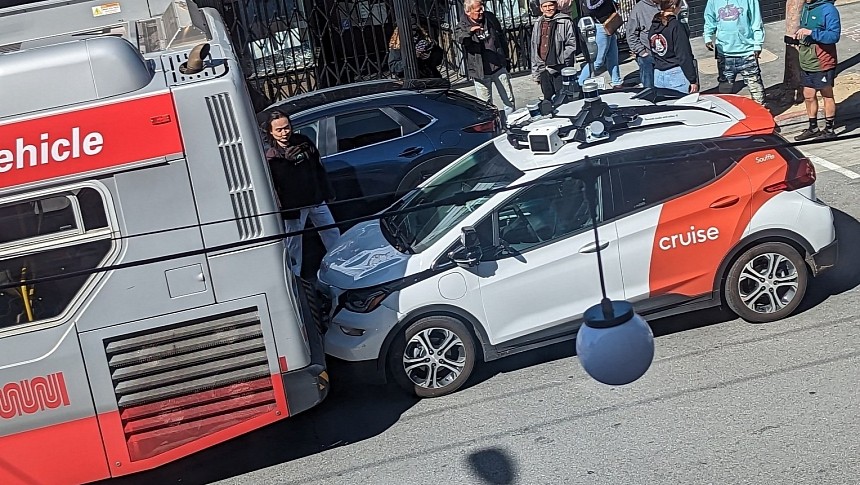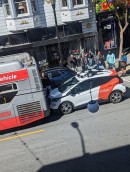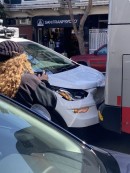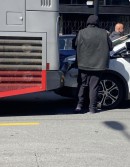On March 24, a Cruise robotaxi crashed into the back of a bus in San Francisco. GM's Cruise has recalled its 300 robotaxis to address the software issue that caused the crash. The company explained what caused the crash, and it's hilarious.
Automated driving is yet to show progress, although people riding in one of Cruise's robotaxis in San Francisco might think otherwise. Cruise, a GM company, operates its commercial robotaxi service in a geofenced area in San Francisco. Despite perfectly "knowing" the site, its robotaxis are frequently involved in road accidents. Most of them are almost nothing, while others are fender-benders.
The crash that occured on March 24 could be classified in the latter category. A Cruise robotaxi driving autonomously crashed into the back of a Muni bus. The accident was strange because it happened in broad daylight, and a bus is a huge target, impossible to miss. Moreover, the crash happened very close to a bus station. Thankfully, Cruise analyzed the car's data and reached a surprising conclusion. It had to do with the fact that the bus was an articulated vehicle, and the Cruise EV remained fixated on the front while it hit the back.
Remember those hilarious training when parents would hide an object, and the toddler thought it magically disappeared? Something like that happened with the Cruise robotaxi. A dog would know that things don't disappear and start looking for them, but Cruise software is not that smart. We wondered how it could miss the huge bas stopped in front of it, and here's the official explanation.
The autonomous-driving software saw the articulated bus and considered it as two different objects when it departed the station. When it straightened up, the front of the bus disappeared, and only the back was visible. The bus then braked and stopped, but the Cruise robotaxi considered that the front of the bus continued its journey and did not brake soon enough to avoid the crash with its back. The robotaxi thus hit the bus at around 10 mph (16 kph).
Cruise has issued a voluntary recall to address the software issue that caused the crash. After testing the fix, the company is confident that this specific issue will not occur after the update. Cruise is trying to understand why the accident happened now, considering that its cars encounter this type of bus daily. It found that the collision occurred due to a unique combination of factors, such as the specific position of the vehicles when the robotaxi approached the bus, its speed, and the timing of the bus's deceleration (within only a few seconds of the front section becoming occluded).
A more serious crash occurred on June 3, 2022, right after Cruise started its commercial service in San Francisco. That night, a Cruise robotaxi carrying one paying customer turned left into traffic and was hit by another car. Passengers in both vehicles were sent to the hospital with non-life-threatening injuries.
The crash that occured on March 24 could be classified in the latter category. A Cruise robotaxi driving autonomously crashed into the back of a Muni bus. The accident was strange because it happened in broad daylight, and a bus is a huge target, impossible to miss. Moreover, the crash happened very close to a bus station. Thankfully, Cruise analyzed the car's data and reached a surprising conclusion. It had to do with the fact that the bus was an articulated vehicle, and the Cruise EV remained fixated on the front while it hit the back.
Remember those hilarious training when parents would hide an object, and the toddler thought it magically disappeared? Something like that happened with the Cruise robotaxi. A dog would know that things don't disappear and start looking for them, but Cruise software is not that smart. We wondered how it could miss the huge bas stopped in front of it, and here's the official explanation.
The autonomous-driving software saw the articulated bus and considered it as two different objects when it departed the station. When it straightened up, the front of the bus disappeared, and only the back was visible. The bus then braked and stopped, but the Cruise robotaxi considered that the front of the bus continued its journey and did not brake soon enough to avoid the crash with its back. The robotaxi thus hit the bus at around 10 mph (16 kph).
Cruise has issued a voluntary recall to address the software issue that caused the crash. After testing the fix, the company is confident that this specific issue will not occur after the update. Cruise is trying to understand why the accident happened now, considering that its cars encounter this type of bus daily. It found that the collision occurred due to a unique combination of factors, such as the specific position of the vehicles when the robotaxi approached the bus, its speed, and the timing of the bus's deceleration (within only a few seconds of the front section becoming occluded).
A more serious crash occurred on June 3, 2022, right after Cruise started its commercial service in San Francisco. That night, a Cruise robotaxi carrying one paying customer turned left into traffic and was hit by another car. Passengers in both vehicles were sent to the hospital with non-life-threatening injuries.
— Kyle Vogt (@kvogt) April 7, 2023







